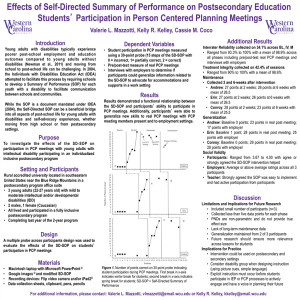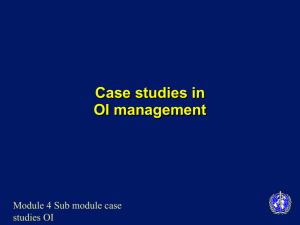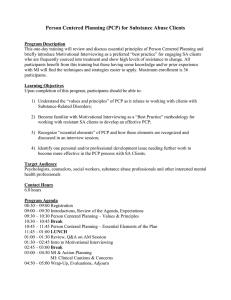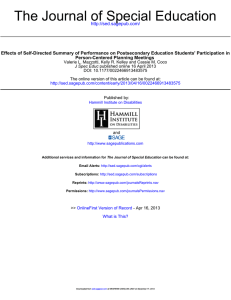Effects of Self-Directed Summary of Performance on Students Additional Results Introduction
advertisement
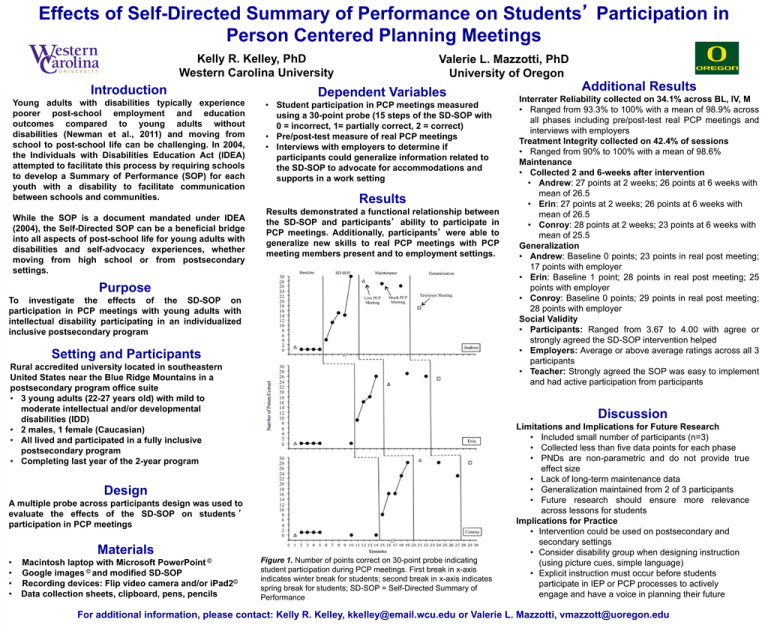
Effects of Self-Directed Summary of Performance on Students’ Participation in Person Centered Planning Meetings Kelly R. Kelley, PhD Western Carolina University Introduction Young adults with disabilities typically experience poorer post-school employment and education outcomes compared to young adults without disabilities (Newman et al., 2011) and moving from school to post-school life can be challenging. In 2004, the Individuals with Disabilities Education Act (IDEA) attempted to facilitate this process by requiring schools to develop a Summary of Performance (SOP) for each youth with a disability to facilitate communication between schools and communities. While the SOP is a document mandated under IDEA (2004), the Self-Directed SOP can be a beneficial bridge into all aspects of post-school life for young adults with disabilities and self-advocacy experiences, whether moving from high school or from postsecondary settings. Valerie L. Mazzotti, PhD University of Oregon Dependent Variables • Student participation in PCP meetings measured using a 30-point probe (15 steps of the SD-SOP with 0 = incorrect, 1= partially correct, 2 = correct) • Pre/post-test measure of real PCP meetings • Interviews with employers to determine if participants could generalize information related to the SD-SOP to advocate for accommodations and supports in a work setting Results Results demonstrated a functional relationship between the SD-SOP and participants’ ability to participate in PCP meetings. Additionally, participants’ were able to generalize new skills to real PCP meetings with PCP meeting members present and to employment settings. Purpose To investigate the effects of the SD-SOP on participation in PCP meetings with young adults with intellectual disability participating in an individualized inclusive postsecondary program Setting and Participants Rural accredited university located in southeastern United States near the Blue Ridge Mountains in a postsecondary program office suite • 3 young adults (22-27 years old) with mild to moderate intellectual and/or developmental disabilities (IDD) • 2 males, 1 female (Caucasian) • All lived and participated in a fully inclusive postsecondary program • Completing last year of the 2-year program A multiple probe across participants design was used to evaluate the effects of the SD-SOP on students ’ participation in PCP meetings Materials Macintosh laptop with Microsoft PowerPoint © Google images © and modified SD-SOP Recording devices: Flip video camera and/or iPad2© Data collection sheets, clipboard, pens, pencils Interrater Reliability collected on 34.1% across BL, IV, M • Ranged from 93.3% to 100% with a mean of 98.9% across all phases including pre/post-test real PCP meetings and interviews with employers Treatment Integrity collected on 42.4% of sessions • Ranged from 90% to 100% with a mean of 98.6% Maintenance • Collected 2 and 6-weeks after intervention • Andrew: 27 points at 2 weeks; 26 points at 6 weeks with mean of 26.5 • Erin: 27 points at 2 weeks; 26 points at 6 weeks with mean of 26.5 • Conroy: 28 points at 2 weeks; 23 points at 6 weeks with mean of 25.5 Generalization • Andrew: Baseline 0 points; 23 points in real post meeting; 17 points with employer • Erin: Baseline 1 point; 28 points in real post meeting; 25 points with employer • Conroy: Baseline 0 points; 29 points in real post meeting; 28 points with employer Social Validity • Participants: Ranged from 3.67 to 4.00 with agree or strongly agreed the SD-SOP intervention helped • Employers: Average or above average ratings across all 3 participants • Teacher: Strongly agreed the SOP was easy to implement and had active participation from participants Discussion Design • • • • Additional Results Figure 1. Number of points correct on 30-point probe indicating student participation during PCP meetings. First break in x-axis indicates winter break for students; second break in x-axis indicates spring break for students; SD-SOP = Self-Directed Summary of Performance Limitations and Implications for Future Research • Included small number of participants (n=3) • Collected less than five data points for each phase • PNDs are non-parametric and do not provide true effect size • Lack of long-term maintenance data • Generalization maintained from 2 of 3 participants • Future research should ensure more relevance across lessons for students Implications for Practice • Intervention could be used on postsecondary and secondary settings • Consider disability group when designing instruction (using picture cues, simple language) • Explicit instruction must occur before students participate in IEP or PCP processes to actively engage and have a voice in planning their future For additional information, please contact: Kelly R. Kelley, kkelley@email.wcu.edu or Valerie L. Mazzotti, vmazzott@uoregon.edu
